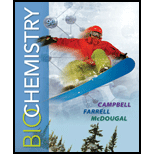
Concept explainers
MATHEMATICAL Calculate the hydroxide ion concentration,
Interpretation:
The hydroxide ion concentration for each material used in Question 24 is to be calculated.
Concept introduction:
Ion product constant for water is defined as the product of concentration of hydronium and hydroxide ion.
Answer to Problem 25RE
Solution:
(a)
(b)
(c)
(d)
Explanation of Solution
a) Saliva,
Calculate the hydrogen concentration as follows:
Or
Substitute
Take antilog on both sides as follows:
And
Calculate the concentration of
Substitute
Rearrange the above equation for
b) Intracellular fluid of liver,
Calculate the hydrogen concentration as follows:
Or
Substitute
Take antilog on both sides as follows:
And
Calculate the concentration of
Substitute
Rearrange the above equation for
c) Tomato juice,
Calculate the hydrogen concentration as follows:
Or
Substitute
Take antilog on both sides as follows:
And
Calculate the concentration of
Substitute
Rearrange the above equation for
d) Grapefruit juice,
Calculate the hydrogen concentration as follows:
Or
Substitute
Take antilog on both sides as follows:
And
Calculate the concentration of
Substitute
Rearrange the above equation for
Want to see more full solutions like this?
Chapter 2 Solutions
Owlv2,1 Term Printed Access Card For Campbell/farrell/mcdougal's Biochemistry, 9th
- The following data were recorded for the enzyme catalyzed conversion of S -> P Question: what would the rate be at 5.0 x 10-5 M [S] and the enzyme concentration was doubled? Also, the rate given in the table is from product accumulation after 10 minuets of reaction time. Verify these rates represent a true initial rate (less than 5% turnover). Please helparrow_forwardThe following data was obtained on isocitrate lyase from an algal species. Identify the reaction catalyzed by this enzyme, deduce the KM and Vmax , and determine the nature of the inhibition by oxaloacetate. Please helparrow_forwardIn the table below, there are sketches of four crystals made of positively-charged cations and negatively-charged anions. Rank these crystals in decreasing order of stability (or equivalently increasing order of energy). That is, select "1" below the most stable (lowest energy) crystal. Select "2" below the next most stable (next lowest energy) crystal, and so forth. A B 鹽 (Choose one) +2 C +2 +2 (Choose one) D 鹽雞 (Choose one) (Choose one)arrow_forward
- 1. Draw the structures for the fats A. 16:2: w-3 and B. 18:3:49,12,15 2. Name each of the molecules below (image attached)arrow_forwarddraw the structures for the fats A. 16:2:w-3 B 18:3:9,12,15arrow_forward1. Below is a template strand of DNA. Show the mRNA and protein that would result. label the ends of the molecules ( refer to attached image)arrow_forward
- Attach the followina labels to the diagram below: helicase, single stranded binding proteins, lagging strand, leading strand, DNA polymerase, primase, 5' ends (3), 3' ends (3) (image attached)arrow_forward1. How much energy in terms of ATP can be obtained from tristearin (stearate is 18:0) Show steps pleasearrow_forwardMultiple choice urgent!!arrow_forward
 BiochemistryBiochemistryISBN:9781305961135Author:Mary K. Campbell, Shawn O. Farrell, Owen M. McDougalPublisher:Cengage Learning
BiochemistryBiochemistryISBN:9781305961135Author:Mary K. Campbell, Shawn O. Farrell, Owen M. McDougalPublisher:Cengage Learning
